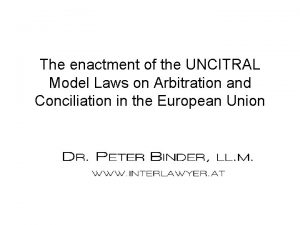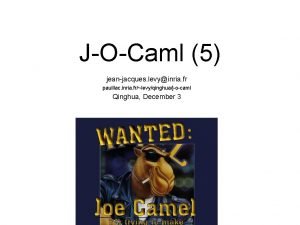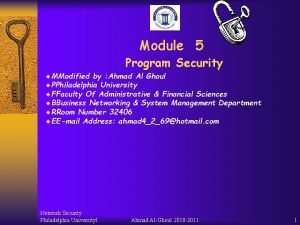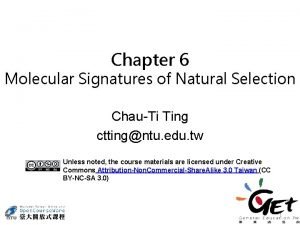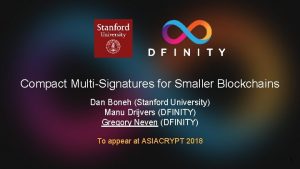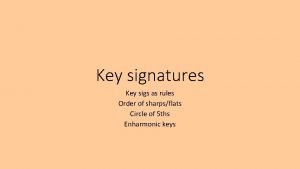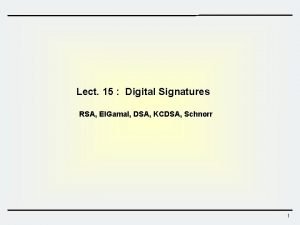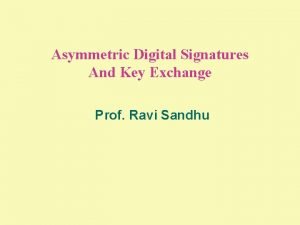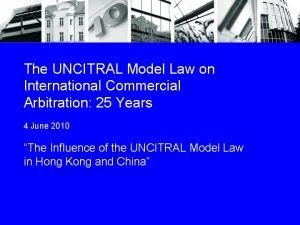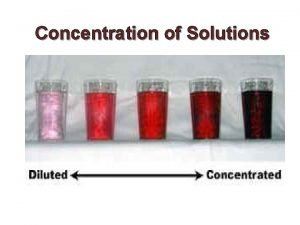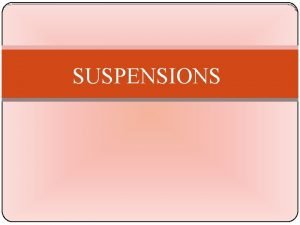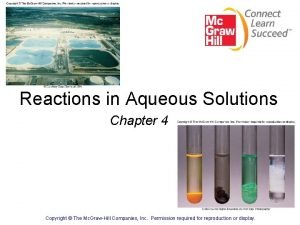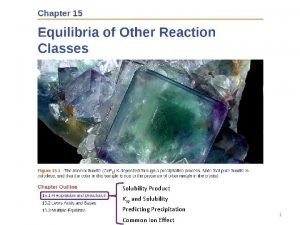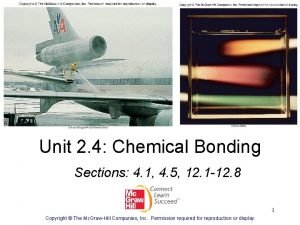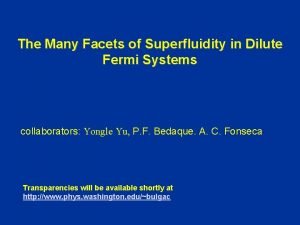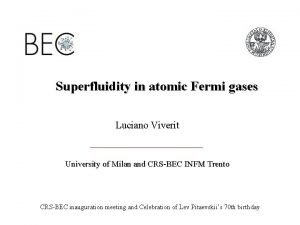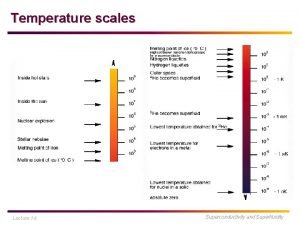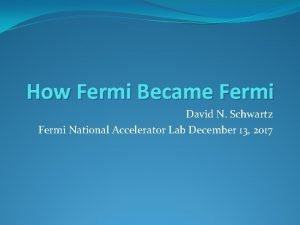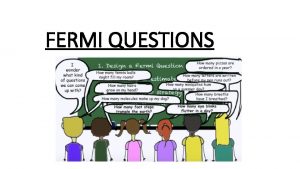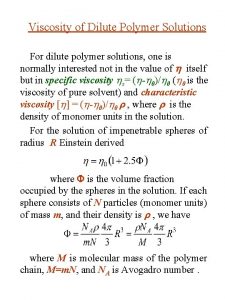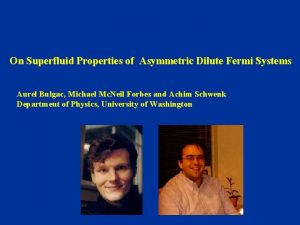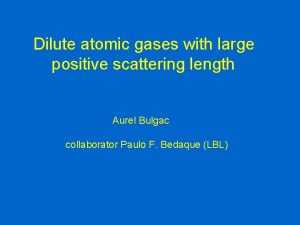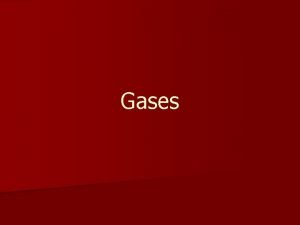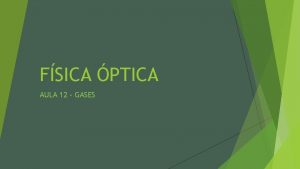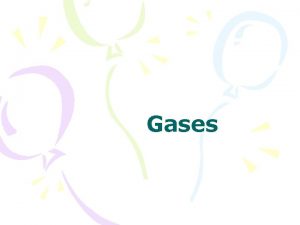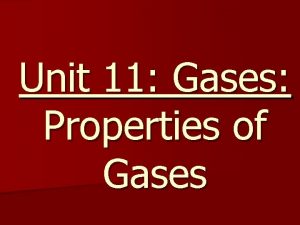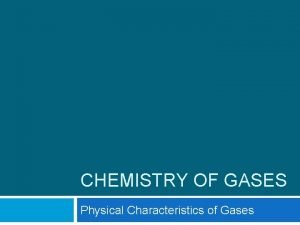Signatures of Superfluidity in Dilute Fermi Gases near


















- Slides: 18

Signatures of Superfluidity in Dilute Fermi Gases near a Feshbach Resonance A. Bulgac (Seattle), Y. Yu (Seattle Lund) P. F. Bedaque (Berkeley), G. F. Bertsch (Seattle), R. A. Broglia (Milan), A. C. Fonseca (Lisbon) These slides will be posted shortly at http: //www. phys. washington. edu/~bulgac/

Topics • Brief/incomplete survey of theory and experiment • Superfluid LDA (SLDA) • Vortex structure • Collective oscillations • Atom – Molecule mixtures

Bertsch Many-Body X challenge, Seattle, 1999 What are the ground state properties of the many-body system composed of spin ½ fermions interacting via a zero-range, infinite scattering-length contact interaction. In 1999 it was not yet clear, either theoretically or experimentally, whether such fermion matter is stable or not. - systems of bosons are unstable (Efimov effect) - systems of three or more fermion species are unstable (Efimov effect) • Baker (winner of the MBX challenge) concluded that the system is stable. See also Heiselberg (entry to the same competition) • Carlson et al (2003) Fixed-Node Green Function Monte Carlo and Astrakharchik et al. (2004) FN-DMC provided best theoretical estimates for the ground state energy of such systems. • Thomas’ Duke group (2002) demonstrated experimentally that such systems are (meta)stable.

Expected phases of a two species dilute Fermi system BCS-BEC crossover T High T, normal atomic (plus a few molecules) phase Strong interaction weak interaction BCS Superfluid a<0 no 2 -body bound state ? weak interactions Molecular BEC and Atomic+Molecular Superfluids a>0 1/a shallow 2 -body bound state halo dimers

Density Functional Theory (DFT) Hohenberg and Kohn, 1964 particle density Local Density Approximation (LDA) Kohn and Sham, 1965 Normal Fermi systems only

Superfluid LDA (SLDA) number and kinetic densities anomalous density Divergent! Cutoff and position running coupling constant! Bogoliubov-de Gennes like equations. Correlations are however included by default!

Chang, Pandharipande, Carlson and Schmidt physics/0404115 Dimensionless coupling constants

Chang et al. physics/0404115 Astrakharchik et al, cond-mat/0406113

Vortex in fermion matter

How can one put in evidence a vortex in a Fermi superfluid? Hard to see, since density changes are not expected, unlike the case of a Bose superfluid. However, if the gap is not small, one can expect a noticeable density depletion along the vortex core, and the bigger the gap the bigger the depletion, due to an extremely fast vortical motion NB Tc unknown in the strong coupling limit!

The depletion along the vortex core is reminiscent of the corresponding density depletion in the case of a vortex in a Bose superfluid, when the density vanishes exactly along the axis for 100% BEC. From Ketterle’s group Fermions with 1/k. Fa = 0. 3, 0. 1, 0, -0. 1, -0. 5 Bosons with na 3 = 10 -3 and 10 -5 Extremely fast quantum vortical motion! Number density and pairing field profiles Local vortical speed as fraction of Fermi speed

Sound in infinite fermionic matter Local shape of Fermi surface Collisional Regime - high T! Compressional mode Spherical Superfluid collisionless low T! Compressional mode Spherical Normal Fermi fluid collisionless - low T! Elongated along Incompressional propagation direction mode Sound velocity First sound Anderson-Bogoliubov sound Landau’s zero sound

Diabatic (approximate) frequency Landau’s zero sound regime Grimm’s group experiment Thomas’ group experiment Transition region from Anderson-Bogoliubov sound to Landau zero sound Adiabatic frequency Anderson-Bogoliubov sound

Adiabatic regime Spherical Fermi surface Perturbation theory result using GFMC equation of state in a trap Frequency shifts in these modes might carry information about possible atom-halo dimer mixture

Consider now a dilute mixture of fermionic atoms and (bosonic) dimers at temperatures smaller than the dimer binding energy (a>0 and a≫r 0) Even though atoms repel there is BCS pairing! One can show that pairing is typically weak in dilute systems! Induced fermion-fermion interaction Bardeen et al. (1967), Heiselberg et al. (2000), Bijlsma et al. (2000) Viverit (2000), Viverit and Giorgini (2000) coherence/healing length

The atom-dimer mixture can potentially be a system where relatively strong coupling pairing can occur. nb a 3 = 0. 064 (solid line) nb a 3 = 0. 037 (dashed line) p-wave pairing (dots)

How this atomic-molecular cloud really looks like in a trap? Core: Molecular BEC Crust: Crust normal Fermi fluid Mantle: Mantle Molecular BEC + Atomic Fermi Superfluid Everything s made of one kind of atoms only, in two different hyperfine states.

Main conclusions Theory: easy hard easy ü Fermion superfluidity, more specificaly superflow, has not yet been demonstrated unambiguously experimentally. There is lots of circumstantial evidence and facts in agreement with theoretical models assuming its existence. Vortices!? ü Theory is able to make very precise predictions in this regime and the agreement with experiment can be check quantitatively.
 Uncitral model law on electronic signatures
Uncitral model law on electronic signatures Ocaml signatures
Ocaml signatures Spectral signatures
Spectral signatures Intruders use virus signatures fabricate
Intruders use virus signatures fabricate Molecular signatures of natural selection
Molecular signatures of natural selection Compact multi-signatures for smaller blockchains
Compact multi-signatures for smaller blockchains Key signature rules
Key signature rules Elgamal digital signature algorithm
Elgamal digital signature algorithm Exchange 2007 signatures
Exchange 2007 signatures Uncitral model law on international commercial arbitration
Uncitral model law on international commercial arbitration Battle ends and down goes
Battle ends and down goes Solutions
Solutions Evaluation of suspension
Evaluation of suspension Dilute strong acid
Dilute strong acid Chapter 4 reactions in aqueous solutions
Chapter 4 reactions in aqueous solutions Types of desizing methods
Types of desizing methods Ksp definition
Ksp definition Dilute and concentrated
Dilute and concentrated Dilute solution definition
Dilute solution definition
